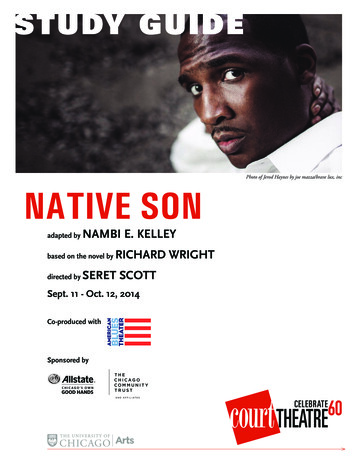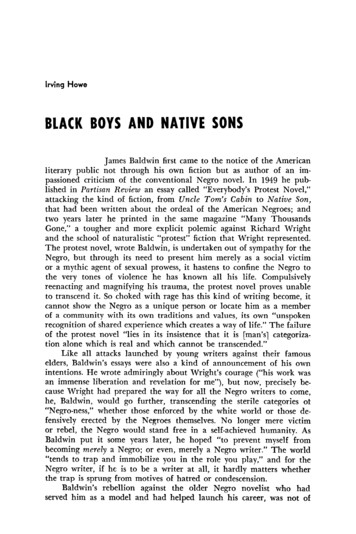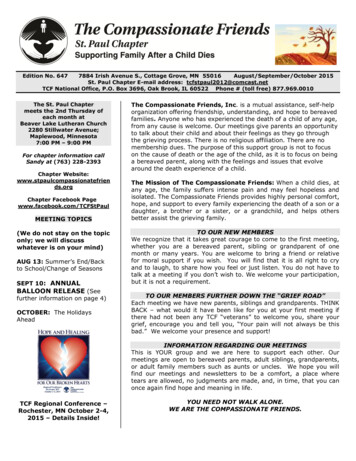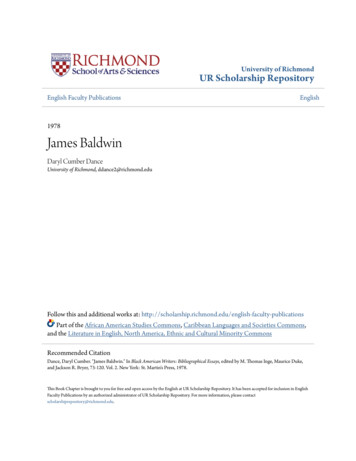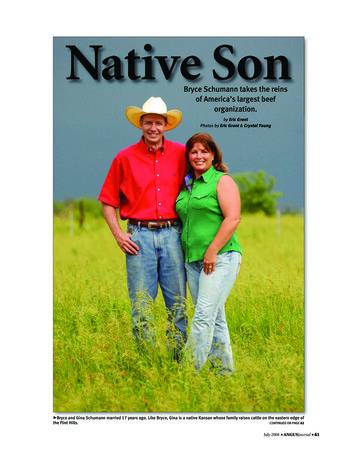
Transcription
Native SonBryce Schumann takes the reinsof America’s largest beeforganization.by Eric GrantPhotos by Eric Grant & Crystal YoungBryce and Gina Schumann married 17 years ago. Like Bryce, Gina is a native Kansan whose family raises cattle on the eastern edge of@the Flint Hills.CONTINUED ON PAGE 62July 2008 ANGUSJournal 61Schumann 07.08.indd 616/16/08 2:11:37 PM
Native Son CONTINUED FROM PAGE 61Every morning, Bryce Schumann tracesthe footsteps of his childhood across therolling hills of eastern Kansas. He rides alongthe same old roads that once took him fromhis family’s farm near Powhattan, Kan., tothe livestock markets of Saint Joseph, Mo.As he crosses over the Missouri River,swollen this summer with muddy water, theBlack Snake Hills rise in the distance.Invariably, his thoughts return to his father,Larry, who brought him this way countlesstimes in the cab of a two-ton truck, trundlingacross the prairie and burgeoning with cattleand hogs bound for the auction barn.“It was always a treat to go to Saint Joe,”Schumann reflects. “There was alwayssomething different to see, always somethingnew to learn.”At the time, Saint Joseph’s terminalmarket was one of the largest in the country.It bustled with the energy of rural America.Its vast network of pens and alleys, whichspread like a chessboard across thebottomland near the river, was filled withcattle and hogs. It contained the highesthopes of farmers and ranchers who traveledthe long miles from their homes to reach themarket in time for the bidding to begin.Looking back, those were formative daysfor Schumann. He learned from his fatherand mother, Annette, the value of honestdealings and the power of a person’s word.He came to appreciate the vastness ofAmerican agriculture, understand theinterconnectedness of farmers, ranchers,feeders, markets and packers, and grasp thecomplexities of producing beef from somany people with so many varied interestsfrom so many far-flung places.He also learned the brittle nature of life.When his father died suddenly in a carcrash, Schumann, who was 13 at the time,was thrust from childhood into unknownterritory. His father, who was a tall, strongman, had anchored his life on the farm. Thepastures and cropland — once sources ofcomfort and familiarity — became vessels ofuncertainty. His future in farming andranching fell into doubt, and the trips heenjoyed so much to Saint Joe — along withAbove: The Schumann family has called eastern Kansas home “from the beginning,” Bryce says.@He grew up on a diversified farming and feeding operation, with cattle, crops and hogs.62 ANGUSJournalSchumann 07.08.indd 62 the livestock market that once dominatedthe region — suddenly became vestiges ofthe past, echoes of a time gone by.“Bryce became who he is today becausewe lost our father at such a young age,” sayssister Lori Thomas of Baker City, Ore. “Itforced him into a role of guiding andprotecting our family. It forced him tobecome a leader. It shaped him into what heis today.”Even now, the key to understandingSchumann can still be found in the rollinghills of eastern Kansas. His wife, Gina, andtheir children — sons Wyatt, Dylan andJessye, and daughter Kassidy — continue toraise cattle near the same pastures of hischildhood home. His mother and stepdad,Stan Larson, remain actively involved in thecattle business.In the evenings, the family often saddlesup horses and rides through their cows. Inhis children, he sees continuation, thepresence of his parents. In the sea of greengrass that surrounds them, he sees the bestof what his life once was. In the gatheringrainstorms, there is hope for a better future.“One hundred years from now, peoplemay read my name in a book,” SchumannJuly 20086/16/08 2:11:43 PM
reflects, “but it’s my family that willbe my living legacy. That’s the truemeasure of success — if you’veraised a family that’s able to moveon and achieve after you’re gone.”No doubt Schumann will needthe support of his family as hebecomes the chief executive officer(CEO) for the American AngusAssociation, which celebrates its125th anniversary this summer.The position, he says, presentedhim the opportunity to apply thevalues he’d learned from his fatherand to be a catalyst of change forrural America by helping cattleproducers across the countrybecome more competitive andconsumer-oriented.“I wanted the opportunity tolead,” he says. “I wanted theopportunity to serve our members.And, I wanted to help move thisorganization forward.”For many in the cattle business,Schumann’s sudden rise to the topspot in the cattle business issomething of a surprise. Hepossesses an unassuming nature. Hedoesn’t seek the spotlight. But thosewho know him best say beneath thequiet veneer there is strength,tenacity and a deeply held commitment torural America.“Bryce has always been superconscientious and super-focused,” Thomassays. “When he does something, he does itright. He looks at the big picture from everyangle. He likes to take input from everyonebefore he makes a decision. He likes to see allangles and hear all opinions. But when hemakes decisions, he’s the kind of person thatnot only moves forward with conviction, healso brings people together.”Schumann’s eldest son, Wyatt, puts it thisway: “He’s always showed us how to dothings the right way. He always says, ‘Takethe time to do things right. Don’t take shortcuts.’ He’s always been very thorough, andhe’s always been there when any of us haveneeded help.”Schumann joined the Association staff in2000 as director of activities. He movedquickly up the ladder, becoming director ofmember services and office management in2001 where he oversaw the daily activities —namely, memberships, registrations andtransfers — of the Association. He alsohelped develop, implement and enforce theorganization’s rules, and he coordinated theAssociation’s efforts to verify identificationand parentage, as well as its defectmonitoring program.Until 2004, when MilfordJenkins was hired, Schumann alsocoordinated efforts for the AngusFoundation.“During the last eight years,Bryce has had the opportunity tolearn just about all aspects of theAssociation’s business,” Gina says.“His vast knowledge of cattle —from production to pedigrees toEPDs (expected progenydifferences) — combined with hisknowledge of businessmanagement give him afoundation that really is unique.”“Bryce’s training in businessmanagement combined with hisexperience in all segments ofAssociation business made him thechoice candidate for CEO,” addsPaul Hill, an Angus breeder fromBidwell, Ohio, and president of theAssociation.The crossroads@Above: “Bryce has the common touch,” Ginasays. “He’s always had a quiet way about him.He’ll do a lot to build relationships with themembers of the Association.”Below: “Dad always says, ‘Don’t take short@cuts,’” says son Wyatt. “He’s always been verythorough, and he’s always been there when anyof us have needed help.”In 2008, the Association findsitself at a crossroads. U.S. cattleproducers, who have enjoyedcheap prices for fuel, feed, fertilizerand land for decades, have watchedprices for these things skyrocket during thelast 18 months.The U.S. packing and feeding sectorscontinue to consolidate, bringing aboutgreater economies of scale and worldwidereach for U.S. products, but raising doubtsCONTINUED ON PAGE 64July 2008 ANGUSJournal 63Schumann 07.08.indd 636/16/08 2:11:49 PM
Native Son CONTINUED FROM PAGE 63about the future role of family farms andranches.Consumer concerns regardinghumane animal-handling practices cameto a flashpoint last winter in California,calling into question the stewardship ofall cattle producers.Schumann believes there is room foroptimism, however. The Angus breednow enjoys a 60% market share in thecommercial cattle industry. Surveysconducted by livestock publicationscontinue to show widespread marketdemand for Angus genetics among U.S.bull buyers at a time when demand forother breeds is declining.Certified Angus Beef LLC (CAB) —the world’s largest branded beef program— continues to occupy a dominantposition in the branded beef business; itsbiggest challenge is not ensuring demandfrom consumers, which grows strongerevery year, but securing enough cattle tomeet the growth of the company.In fact, CAB projects it will break alltime production records during 2008with more than 600-plus million poundsof beef sold through the program. By 2020,CAB hopes to crack the 1-billion-poundceiling.“To make sure that happens, we’re goingto have to become even more aggressivethan we’ve been in the past,” Schumannsays. “We’re going to have to look for waysto find new opportunities. We’re goingto need to look for ways to develop newmarkets, create new enthusiasm and getthe people excited about the Angusbusiness.”Schumann says he will focus on threeprimary objectives during the initialstages of his leadership.First, at its meetings in June, theAssociation’s Board of Directors ratifieda new management structure proposedby Schumann for the Association and itsentities. The restructuring, which puts inplace an executive management teamconsisting of the presidents of each of theAssociation’s entities — CAB, AngusProductions Inc. (API), Angus GeneticsInc. (AGI), and the Angus Foundationalong with a chief operating officer(COO) for the American AngusAssociation and departmental vicepresidents — will provide for greatercoordination of activities, improvedmembership service and enhancedcommunication between the variousentities.“Bryce came to us in June and64 ANGUSJournalSchumann 07.08.indd 64 @Above: Kassidy is the youngest of the fourSchumann kids, and the only girl.Below: The opportunity of Angus is the oppor@tunity to continue. Dylan represents the nextgeneration of Schumanns to raise cattle in eastern Kansas.presented to us the plan forrestructuring,” Hill says. “He felt it wouldpull upon the talents that he had at hisdisposal at each of the variousorganizations. He felt we would be betterserved by having the best minds withinour organization working more closelytogether and communicating morefrequently. It brings everybody to thetable to talk, to consult, to makedecisions collaboratively.”Adds Schumann: “It’s my job to listen.It’s my job to act on the best informationavailable. I owe that to our membership.This structure will make that possible.”Second, Schumann believesinformation and technology, the key tothe success of the Angus breed over theyears, will play an even more critical rolein the coming years as the industrybecomes more consolidated and theeconomics of raising cattle become morechallenging.“Our success in the past has been builton our ability to make hard decisions atcritical times,” Schumann says. “We’vebeen open to trying new technologieswhen others were reluctant to do so. We’velooked at new ideas when others didn’t seethem. And, that’s been the spirit of the Angusbusiness, and that’s paid us incredibledividends over time.“The greatest thing about ourmembership is its ability to adopt newtechnology,” he says. “Over half the cattlewe registered last year were the productof artificial insemination (AI). About12% of the cattle we registered last yearwere the product of embryo transfer(ET). I think new technology will be ourgreatest challenge and our greatestsalvation. With the high cost of feed,identifying those genetics that are mostefficient will become our highest priority.“The way we identify those highlyefficient [individuals] is to continue tohave groundbreaking information that ispublicly available to all cattle producers,whether they are small, medium orlarge,” Schumann continues. “Thepublic sire summary and geneticevaluation programs that we haveoffered our members and thecommercial industry have really set usapart from the pork and poultrybusinesses. Those industries didn’t haveopen sire summaries, and now thoseindustries have consolidated into thehands of very few companies.“But when you have greaterinformation on a public basis,” heJuly 20086/16/08 2:11:56 PM
continues, “that gives individualpeople in this business greateropportunity because they canmake their own decisions.Through our genetic evaluationefforts, we have to be inventiveand think outside traditionalparameters. Our first obligationis providing our members — andtheir customers — with the toolsthey need to remaineconomically viable.”Third, Schumann believes theAssociation’s ultimate objectivewill be continuing to ensure theproducts Angus producers bringto market meet consumerneeds.“The reason the Angus breedhas been successful is becauseduring our toughest times, wewere able to make difficultdecisions,” he says. “With theestablishment of CAB, wereached out to the consumerrather than pulling back. We moved forwardrather than retreating. We created anopportunity that no one knew was there,and that opportunity has become one of thegreatest success stories in America. Ask anyperson on the street what the definition ofquality beef is, and almost all of them will tellyou ‘Angus.’“As Angus producers, we need tocontinue to reach farther,” he says.“We have to be innovative in the wayswe communicate with consumers. Wehave to find new ways of deliveringproducts to the marketplace. We haveto be sensitive to what’s taking placewith consumers across the country,and we have to be positioned to createnew opportunities. The lessons of thepast — and the blueprint for ourfuture — are really pretty simple: If weproduce a superior product, we’ll haveloyal customers. Our livelihood, morethan ever before, depends on it.”Into the futureStanding in a pasture and looking tothe north, Bryce and Gina hear thebawling of cattle as their four kids trailthem across a wide pasture. The hootsand hollers of their children’s voicescarry on the breeze.It’s strange, Schumann says, that injust a few years their children will begrown up and moving on into theirown lives, in their own way and ontheir own terms. The cyclical nature of“There are a lot of things my father taught me,” Bryce says. “Never quit until the job is done. Do@the job right the first time. Don’t cut corners. Your word is your bond.”raising cattle and families continues; theloop will close once again.Perhaps the greatest lesson of farmingand ranching is that the true value of raisingAngus is not what the markets will bear onany given day; rather, the breed has come torepresent an opportunity for many tocontinue, a way to see the next generationtrace the footsteps of their fathers andmothers, to watch them take that first,critical step down their own trail to thefuture.“I want people to know I’m a familyman,” Schumann says. “I want peopleto know I’m a product of 4-H andyouth programs. I want people toknow I’m someone who is passionateabout animal agriculture. I want toopen a dialogue within ourorganization about the importance ofbeing involved in the beef industry,and I want the people who buy ourproduct — in every market across thecountry and around the world — toknow how farms and ranches like myfamily’s touch their lives and makethem better.”Ultimately, this is what Schumann’sfather taught him. Which makes it easyto ask him this question: What wouldyour father say to you now that you’vetaken the helm of the one of the world’slargest and most innovative agriculturalorganizations?“I hope he’d be proud,” Schumannsays. “I think he’d shake my hand, giveme a hug and tell me I did a good job.This is a dream come true for me.”July 2008 ANGUSJournal 65Schumann 07.08.indd 656/16/08 2:12:02 PM
Native Son Bryce Schumann takes the reins of America's largest beef organization. by Eric Grant Photos by Eric Grant & Crystal Young @Bryce and Gina Schumann married 17 years ago. Like Bryce, Gina is a native Kansan whose family raises cattle on the eastern edge of the Flint Hills. CONTINUED ON PAGE 62 Schumann 07.08.indd 61 6/16/08 2:11:37 PM
